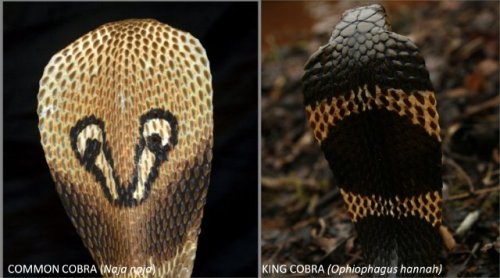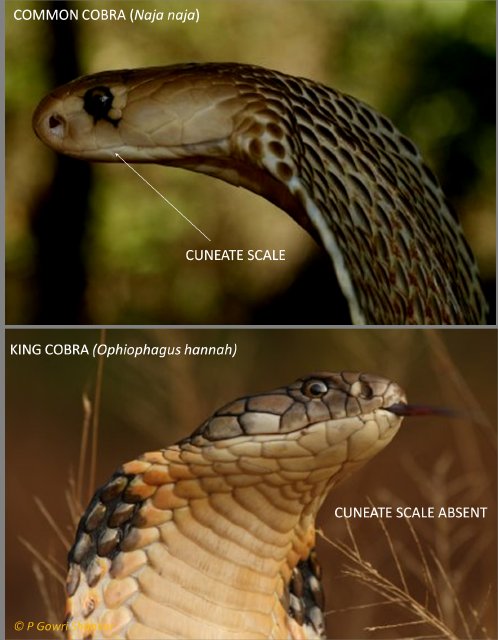Many people cannot tell between a Common Cobra(Naja naja) from a King Cobra(Ophiophagus hannah). It may sound absurd to a few but from my experience the majority belong to the latter category. I have watched television anchors and news readers confidently make this mistake, newspapers whose editors care less to be corrected in spite of my efforts to explain and sadly the rest would rather believe these poorly researched mediums than a lamenting herpetologist! Hence this article to list the basic differences between the two snakes but does not delve into detailed taxonomic or behavioral differences.
SIZE
HOODS
COLOUR AND MARKING

Common Cobra: Varies between light to dark shades of brown.
Has a spectacle mark behind its hood.
King Cobra: Shades of black, brown and olive green.
Has light yellow to cream coloured chevron shaped markings from head to tail
SCALES

Common Cobra: Cuneate scale is present
King Cobra: Cuneate scale is absent

- Common Cobra: Occipital scales absent
King Cobra: Occipital scales present
FOOD

Common Cobra:Frogs, lizards, birds, snakes and small mammals like rats and hare. They are opportunistic and sometimes eat their own kind.
King Cobra: Eat only other snakes. E.g. Rat snakes(Ptyas mucosa), cobras(Naja naja), malabar pit vipers(Trimeresurus malabaricus). They occasionally feed on monitor lizards. They are cannibalistic.
REPRODUCTION

Common Cobra: Lays eggs in holes and crevices (Pic taken during rescue)
King Cobra: Builds a nest to lay eggs.
Summary and few more differences…
| Common Cobra (Naja naja) | King Cobra (Ophiophagus hannah) | |
| Size (length) | Usually grows up to 5.5 feet | In India they grow up to 15 feet |
| Hood | Broad | Narrow |
| Color and markings | Varies between light to dark shades of brown.Has a spectacle mark behind its hood. | Shades of black, brown and olive green.Has light yellow to cream coloured chevron shaped markings from head to tail |
| Scales | Cuneate scale is presentNo occipital scales | Occipital scales are presentNo cuneate scale. |
| Food | Frogs, lizards, birds, snakes and small mammals like rats and hare. They are opportunistic sometimes eating their own kind. | Eat only other snakes. E.g. Rat snakes(Ptyas mucosa), cobras(Naja naja), malabar pit vipers(Trimeresurus malabaricus). They occasionally feed on monitor lizards.They are cannibalistic. |
| Reproduction | Lays eggs in holes and crevices | Builds a nest to lay eggs |
| Genus | Naja meaning true cobra | Ophiophagus meaning ‘snake eating’. King cobras are monotypic, meaning only one type under this genus |
| Venom toxicity (Neurotoxic) | Highly toxic but quantity is low. | Less toxic but quantity is high |
| Venom quantity | 2cc | 7cc |
| Habitat | Mainland India except the north-east. | Western Ghats, West Bengal, north-east, Orissa and parts of Eastern Ghats(AP) |
Feel free to share your thoughts and more differences which you think might help people in understanding these snakes better.
Authors: Sharmila & Gowri Shankar
Acknowledgements: Ashwini VM, Vivek Sharma, Avinash Bhagat, Vaibhav Patwardhan


